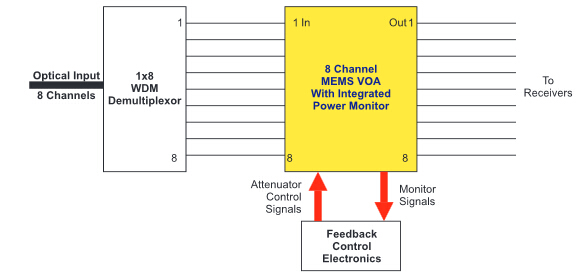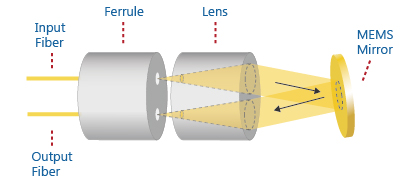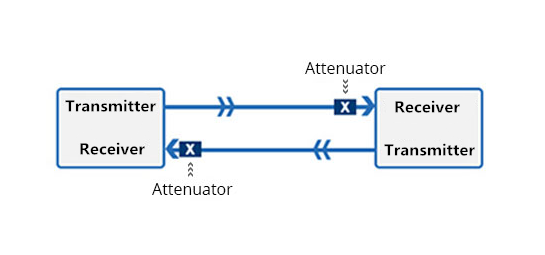What is Fiber Optic Attenuator?
The signal power in fiber optic links is sometimes needed to be strengthened to achieve long-haul data transmission. While under certain circumstances, too much signal power can overload fiber optic receivers and even damage the optical network. To reduce the power in fiber links, fiber optic attenuators are leveraged. This article will shed light on the types, working principles, and applications of fiber optic attenuators, which will help you gain a comprehensive understanding of fiber optic attenuator.

What Are Fiber Optic Attenuators?
Fiber optic attenuators, also called optical attenuators, are passive devices used to reduce the power level of an optical signal. Since too much light may saturate the fiber optic receiver, optical attenuators are often deployed in the system to reduce the light power and achieve the best fiber optic system performance. Generally, multimode systems do not need attenuators as the multimode sources, even VCSELs, rarely have enough power output to saturate receivers. Instead, for single-mode systems, especially the long-haul DWDM network links, fiber optic attenuators are necessary for balancing the optical power during the transmission.

How Many Types of Fiber Optic Attenuators Are There?
Fiber optic attenuator takes a number of different forms. You can find many optical attenuators types in the market with different classification perspectives such as the connector type, cable type, etc. Generally, they are widely accepted to be grouped as fixed optical attenuators (FOA) and optical variable attenuators (VOA). While considering the types of cables, they can also be divided into single-mode and multi-mode attenuators.
Fixed Optical Attenuator
Fixed attenuator, as the name of which has indicated clearly, is designed to have an unchanging level of attenuation in optical fiber, expressed in dB, typically between 1dB and 30dB, such as 1dB, 5dB, 10dB, etc. Fixed optical attenuators may use a variety of principles for their functioning. Preferred optical attenuators often use either doped fibers, or misaligned splices, or total power while non-preferred attenuators often use gap loss or reflective principles.
As shown in the figure below, fixed value attenuators consist of in-line type and connector type. In-line type looks like a plain fiber patch cable. The in-line type optical attenuators are incorporated into patch cables. Connector type attenuator looks like a bulkhead fiber connector. Usually, it has a male plug connector at one side to allow fiber attenuator to be plugged directly into receiver equipment or adapters in patch panel, and at the other side there is a female type fiber optic adapter to allow the patch cords to plug in. There are also female to female optical attenuators, which can be used as adapters and attenuators at the same time. Their applications include telecommunication networks, optical fiber test facility, Local Area Network (LAN) and CATV systems.
fixed value attenuators
Optical Variable Attenuator
Optical variable attenuator, or variable optical attenuator (VOA), generally uses a variable neutral density filter. VOA is generally used for testing and measurement, but it is also widely adopted in Erbium-Doped Fiber Amplifier (EDFA) for equalizing the light power among different channels. It has advantages of being stable, wavelength insensitive, mode insensitive, and offering a large dynamic range.
Basically, there are two types of optical variable attenuators: stepwise variable attenuators and continuously variable attenuators. Stepwise variable attenuators can change the attenuation of the signal in known steps such as 0.1dB, 0.5dB or 1dB. Continuously variable optical attenuators can provide a precise level of attenuation through flexible adjustment. Thus, operators are able to adjust the attenuator to accommodate the changes required quickly and precisely without any interruption to the circuit.
Optical Variable Attenuator
Single Mode and Multimode Fiber Optic Attenuator
Since fiber optic attenuators can be used with two types of fiber cables, single mode and multimode, optical attenuators can be classified into single mode type and multimode type. Fiber optic attenuators are usually used in single mode long-haul applications. Accordingly, the commonly used type is also single mode type. However, although fiber optic attenuators are normally used for single mode, there are also multi-mode fiber optic attenuators available to mate with multi-mode fiber cables. When choosing one type of optical attenuator over another one, it is necessary to consider the attenuation range and the wavelength.
Working Principles of Fiber Optic Attenuators
Optical attenuators achieve the desired attenuation in optical fiber links in three different principles, which relatively are gap-loss principle, absorptive principle, and reflective principle.
Gap-loss Principle
With the principle of gap loss, power reduction is achieved by inserting the device in the fiber path with an in-line configuration. Gap-loss attenuators are placed close to the transmitter to prevent the saturation of the receiver. They use a longitudinal gap between two optical fibers so that the optical signal passed from one optical fiber to another can be reduced. This principle allows the light from the transmitting optical fiber to spread out as it leaves the optical fiber. When the light gets to the receiving optical fiber, part of the light is lost in the cladding because of a gap and the spreading occurred. These optical attenuators should be kept close to the transmitter to ensure its effective performance. To reduce the signal farther down the fiber path, an optical attenuator using absorptive or reflective techniques would be more suitable.

Gap-loss principle
Absorptive Principle
The absorptive principle, or absorption, accounts for a fraction of power loss in optical fiber. This is because optical fiber absorbs optical energy and converts it to heat. Absorptive principle can be employed to design an optical attenuator with a known reduction of power. The absorptive principle uses material in the optical path to absorb optical energy. The principle is simple but can be an effective way to reduce the power being transmitted and received.

Reflective Principle
The reflective principle, or scattering, accounts for a fraction of power loss in optical fiber and also results from the imperfections of optical fiber. But in this case, it causes the signal to scatter. The scattered light inserts interference in the optical fiber, thereby reducing the amount of transmitted and received light. This principle can be employed in the planned attenuation of a signal. The material used in the fiber optic attenuator is manufactured to reflect a known quantity of the signal, thus allowing only the desired portion of the signal to be propagated.

Fiber Optics Attenuators - How they work?
An optical attenuator is a passive device used to reduce the power level of an optical signal, either in free space or in an optical fiber. There are various types of them from the fixed ones, step-wise variable, and continuously variable.

Attenuators are usually used when the signal arriving at the receiver is too strong and hence may overpower the receiving elements. This may occur because of a mismatch between the transmitters/receivers, or because the media converters are designed for a much longer distance than for which they are being used.
Sometimes attenuators are also used for stress testing a network link by incrementally reducing the signal strength until the optical link fails, determining the signal’s existing safety margin.
Although fiber optic attenuators are normally used in SM (Single Mode) circuits, because this is where the stronger lasers are used for distance transmission, there are also multi mode attenuators available.
The most common version of attenuators are male to female units, often called plug-style or buildout style. These plug-style attenuators simply mount on one end of a fiber optic cable, allowing that cable to be plugged into the receiving equipment or panel.
beyondtech attenuators available
There are also female to female (bulkhead) attenuators, often used to mount in patch panels or for connecting two fiber optic cables together. More expensive, but useful for testing, are variable attenuators which are adjustable between 1dB and 30dB.
Bear in mind that the dB ratings are a measure of signal strength and can sometimes be confusing. The chart below will give you an idea of the percent of attenuation of your signal for specific dB values.
When to Use Fiber Optic Attenuators?
Considering when to use fiber optic attenuators in your system, there are generally two different situations where you will need fiber optic attenuators.
One is when fiber optic attenuators are used to reduce the receiver power. There are sometimes when signal arriving at the receiver is too strong and may overpower the receiving elements. Usually, the receiver power depends on two factors: how much power is launched into the fiber and how much power is lost by the attenuator. Too much receiver power can be mainly caused by the mismatch between the transmitters/receivers, or caused by the use of media converters designed for a much longer distance. In this case, optical attenuators can be permanently installed in the fiber optic link to reduce the signal power and properly match the signal level.

The other one is when the attenuators are used for testing the power level margins. When testing the optic power level, the attenuators are used to temporarily add a calibrated amount of signal loss to test the power level margins in the fiber optic system. With the transmitter turned on and using a fiber optic power meter which is set to the system operating wavelength, the attenuator can be used to test the system power.
Conclusion
Fiber optic attenuator is an essential component for reducing optical power in data transmission. Signals achieve a more precise power level with the help of optical attenuators. According to different applications, you’d better choose the most appropriate type of optical attenuators for your system.



